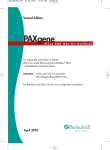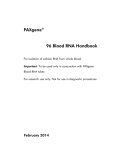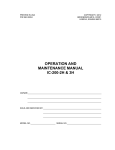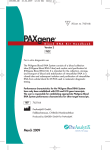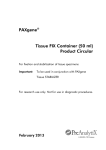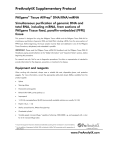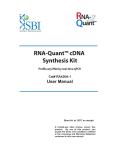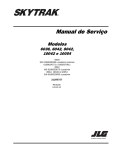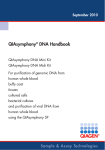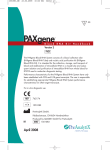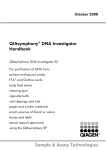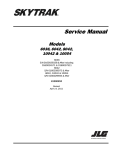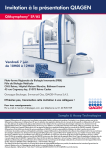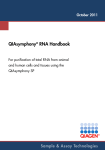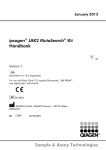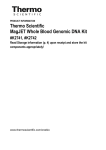Download QIAsymphony PAXgene Blood RNA Kit Handbook
Transcript
August 2014 Important Note Dear QIAsymphony PAXgene Blood RNA Kit user, A temperature of –80°C is usually recommended for storing isolated RNA. Please note that we also recommend storing RNA purified with the QIAsymphony® PAXgene® Blood RNA Kit at a temperature of –80°C. Please note that Buffer RDD, provided in the QIAsymphony PAXgene Blood RNA Kit, is equivalent to Buffer QSX1, as it is named in the QIAsymphony SP software. If you are using the Wizard or if Buffer RDD has not been scanned and correctly placed, the QIAsymphony SP will request that you place Buffer QSX1 on the instrument. In this case, place Buffer RDD from the QIAsymphony PAXgene Blood RNA Kit in the position specified by the QIAsymphony SP for Buffer QSX1. Please also note that the DNase I solution should be placed in position 3 of the enzyme rack, labeled “ETDN” and not in position 2, which is used for the second proteinase K vial. The QIAsymphony PAXgene Blood RNA Kit Handbook (Second Edition, January 2012, page 16) incorrectly refers to position 2 for the DNase I solution. The enzyme rack is correctly labeled with “ETDN” for the DNase I solution at position 3. For further information, please contact one of the QIAGEN Technical Service Departments or distributors (see the back cover of our handbooks or visit www.qiagen.com). Best regards, PreAnalytiX Trademarks: PAXgene®, PreAnalytiX® (PreAnalytiX GmbH); QIAGEN®, QIAsymphony® (QIAGEN Group). www.PreAnalytiX.com 1087423 08/2014 QIAsymphony PAXgene ® ® B l o o d R N A K i t H a n d b o o k For purification of cellular RNA from whole blood using the QIAsymphony SP instrument. To be used only in conjunction with PAXgene Blood RNA Tubes When the QIAsymphony PAXgene Blood RNA Kit is used in conjunction with the PAXgene Blood RNA Tube, the System provides purified intracellular RNA, including miRNA for research tests including but not limited to RT-PCR. The QIAsymphony PAXgene Blood RNA System is intended for Research Use Only. Not for use in diagnostic procedures. Second Edition January 2012 Trademarks: PAXgene®, PreAnalytiX® (PreAnalytiX GmbH.); QIAGEN®, QIAsymphony®, HRM®, MagAttract®, Rotor-Gene® (QIAGEN Group); BD Hemogard™ (Becton Dickinson and Company, Franklin Lakes, NJ, USA); Agilent® (Agilent Technologies, Inc.); Eppendorf® (Eppendorf AG); SpeedVac® (Thermo Savant, Inc.); SYBR® (Molecular Probes, Inc.); VWR® (VWR International, Inc.). Limited License Agreement Use of this product signifies the agreement of any purchaser or user of the QIAsymphony PAXgene Blood RNA Kit to the following terms: 1. The QIAsymphony PAXgene Blood RNA Kit may be used solely in accordance with the QIAsymphony PAXgene Blood RNA Kit Handbook and for use with components contained in the Kit only. PreAnalytiX grants no license under any of its intellectual property to use or incorporate the enclosed components of this Kit with any components not included within this Kit except as described in the QIAsymphony PAXgene Blood RNA Kit Handbook and additional protocols available at www.preanalytix.com. 2. Other than expressly stated licenses, PreAnalytiX makes no warranty that this Kit and/or its use(s) do not infringe the rights of third-parties. 3. This Kit and its components are licensed for one-time use and may not be reused, refurbished, or resold. 4. PreAnalytiX specifically disclaims any other licenses, expressed or implied other than those expressly stated. 5. The purchaser and user of the Kit agree not to take or permit anyone else to take any steps that could lead to or facilitate any acts prohibited above. PreAnalytiX may enforce the prohibitions of this Limited License Agreement in any Court, and shall recover all its investigative and Court costs, including attorney fees, in any action to enforce this Limited License Agreement or any of its intellectual property rights relating to the Kit and/or its components. For updated license terms, see www.preanalytix.com. © 2012 PreAnalytiX GmbH, all rights reserved. PreAnalytiX Company PreAnalytiX GmbH Feldbachstrasse CH – 8634 Hombrechtikon Switzerland www.preanalytix.com PreAnalytiX Distributors PreAnalytiX products are manufactured for PreAnalytiX by QIAGEN or BD and are distributed for PreAnalytiX by QIAGEN or BD. Products cannot be ordered at PreAnalytiX GmbH. Please see the last pages for contact information for your local PreAnalytiX distributor. Contents Intended Use 4 Summary and Explanation 4 Principle of the Procedure 5 Materials Provided 6 Kit contents Materials Required but Not Provided Warnings and Precautions 6 7 8 Reagent Storage and Handling 10 Specimen Handling and Storage 11 Procedure 12 Automated purification on the QIAsymphony SP 12 “Reagents and Consumables” drawer 12 “Waste” drawer 14 “Eluate” drawer 14 Inventory scan 15 Protocol Purification of total RNA, including miRNA, from whole blood collected in PAXgene Blood RNA Tubes 16 Troubleshooting guide 21 Quality Control 24 References 24 Contact Information 24 Appendix A: General Remarks on Handling RNA 25 Appendix B: Quantification and Determination of Quality of Total RNA 25 Ordering Information 29 PreAnalytiX Worldwide 32 QIAsymphony PAXgene Blood RNA Kit Handbook 01/2012 3 Intended Use For Research Use Only. Not for use in diagnostic procedures. No claim or representation is intended to provide information for the diagnosis, prevention, or treatment of a disease. The performance characteristics of this product have not been fully established. All due care and attention should be exercised in the handling of the products. The QIAsymphony PAXgene Blood RNA Kit is intended for purification of intracellular RNA, including miRNA, from human whole blood (4.8 x 106 – 1.1 x 107 leukocytes/ml). The QIAsymphony PAXgene Blood RNA Kit is not for the isolation of genomic DNA or viral nucleic acids from human whole blood. Summary and Explanation QIAsymphony technology combines the speed and efficiency of silica-based nucleic acid purification with the convenient handling of magnetic particles (Figure 1). The purification procedure is designed to ensure safe and reproducible handling of potentially infectious samples. The QIAsymphony PAXgene Blood RNA Kit allows automated, standardized purification on the QIAsymphony SP of total RNA, including miRNA, from 2.5 ml human whole blood collected into PAXgene Blood RNA Tubes. Proven MagAttract® magnetic-particle technology provides high-quality RNA, which is suitable for direct use in downstream applications. The QIAsymphony SP performs all steps of the sample preparation procedure. Up to 72 samples, in 3 batches of 24, can be processed in a single run. 4 QIAsymphony PAXgene Blood RNA Kit Handbook 01/2012 Magnetic rod Magnetic rod Fast up and down movement of rod cover to release magnetic particles Slow up and down movement to collect magnetic particles Rod cover Rod cover Transfer Reagent 1 and magnetic particles Reagent 2 and magnetic particles Well 1 Well 2 Figure 1. Schematic of the QIAsymphony SP principle. The QIAsymphony SP processes a sample containing magnetic particles as follows. A magnetic rod protected by a rod cover enters a well containing the sample and attracts the magnetic particles. The magnetic rod cover is positioned above another well and the magnetic particles are released. The QIAsymphony SP uses a magnetic head containing an array of 24 magnetic rods, and can therefore process up to 24 samples simultaneously. Steps 1 and 2 are repeated several times during sample processing. Principle of the Procedure The simple procedure begins with a centrifugation step to pellet the contents of each PAXgene Blood RNA Tube. After decanting the supernatant, the pellets are then resuspended by vortexing in optimized buffers, which are supplemented with proteinase K. The tubes are transferred to the QIAsymphony SP. After a precleaning step, RNA binds to the silica surface of MagAttract magnetic particles in the presence of a chaotropic salt and isopropanol. Two prewash steps guarantee that DNase I digestion is optimized. Remaining proteins and contaminants are removed by an additional proteinase K treatment and 3 wash steps, and RNA is eluted in Buffer BR5. Finally, a heat treatment of the eluted RNA provides ready-to-use RNA and ensures consistent performance in downstream applications. Guaranteed yields of RNA isolated from 2.5 ml healthy, human, whole blood (4.8 x 106 – 1.1 x 107 leukocytes/ml) are ≥3 µg for >95% of the samples processed. Since yields are highly donor-dependent, individual yields may vary. Average yields can be expected in the range between 8 and 16 µg. Purified RNA can be used in downstream applications including but not limited to RT-PCR. QIAsymphony PAXgene Blood RNA Kit Handbook 01/2012 5 Materials Provided Kit contents QIAsymphony PAXgene Blood RNA Kit Catalog no. (96) 762635 Number of preps 96 Buffer BR2 25 ml Buffer BR5 30 ml Buffer QSX2 30 ml Buffer RDD 30 ml Proteinase K 2 x 1.4 ml DNase I (1500 Kunitz units)* 4 glass vials RNase-Free Water 2 x 2 ml Reagent Cartridge† 2 Piercing Lid 2 Reuse Seal Set 2 Secondary Hemogard Closures 2 x 50 Elution Microtubes CL, racked‡ 2 55 x 8 Caps for Elution Microtubes ‡ Handbook 1 * Kunitz units are the commonly used units for measuring DNase I; see page 16 for definition. † Prefilled reagent cartridges include buffers that contain a guanidine salt, ethanol, isopropanol, and/or proteinase K. See pages 8–10 for safety information. ‡ Also available separately. See page 29 for ordering information. 6 QIAsymphony PAXgene Blood RNA Kit Handbook 01/2012 Materials Required but Not Provided When working with chemicals, always wear a suitable lab coat, disposable gloves, and protective goggles. For more information, consult the appropriate material safety data sheets (MSDSs), available from the product supplier. Consumables • 8-Rod Covers (cat. no. 997004) • Sample Prep Cartridges, 8-well (cat. no. 997002) • Filter-Tips, 1500 µl (cat. no. 997024) • Filter-Tips, 200 µl (cat. no. 990332) • Sterile, aerosol-barrier, RNase-free pipet tips* • RNase-free syringe and needle (for resuspension of DNase I) • Crushed ice Reagents • PAXgene Blood RNA Tubes (cat. no. 762165; available from BD and BD authorized distributors; see www.PreAnalytiX.com) Equipment • QIAsymphony SP (cat. no. 9001297) • Optional: QIAsymphony Cabinet SP (cat. no. 9020244) • Pipets† (200 µl – 1 ml) • Centrifuge† capable of attaining 3000–5000 x g and equipped with a swing-out rotor and buckets to hold PAXgene Blood RNA Tubes • Vortex mixer† • Optional: A step dispenser,† such as the Multipette plus from Eppendorf, is recommended for optimal processing‡ • Optional: A multitube vortexer,† such as the VX2500 from VWR, is recommended for optimal processing‡ * Ensure that you are familiar with the guidelines on handling RNA (Appendix A, page 25). † Ensure that instruments have been checked and calibrated regularly according to the manufacturer‘s recommendations. ‡ This is not a complete list of suppliers and does not include many important vendors of biological supplies. QIAsymphony PAXgene Blood RNA Kit Handbook 01/2012 7 Elution in Elution Microtubes CL Equipment • PAXgene 96 Incubator Block (cat. no. 9238279) • Incubator capable of 80°C* • Spatula to remove the lower plate from the elution microtube rack • Heavy plate to prevent caps from opening during incubation at 80°C Elution in 2 ml Sarstedt tubes Consumables • Micro tube 2ml, PP (Sarstedt, cat. no. 72.608) with Screw cap, neutral (Sarstedt, cat. no. 65.716.725)† Equipment • Shaker–incubator, heating block, or water bath* capable of incubating at 65°C For other possible elution formats see www.qiagen.com/products/qiasymphonysp.aspx under user support. Warnings and Precautions When working with chemicals, always wear a suitable lab coat, disposable gloves, and protective goggles. For more information, please consult the appropriate material safety data sheets (MSDSs). These are available online in convenient and compact PDF format at www.preanalytix.com/RNA_msds.asp where you can find, view, and print the MSDS for this kit. CAUTION: DO NOT add bleach or acidic solutions directly to the sample-preparation waste. The bottles and the troughs of the reagent cartridges contain Buffer BR2 and Buffer QSB1 which contain guanidine thiocyanate, and Buffer QSW5, which contains guanidine hydrochloride. Guanidine thiocyanate and guanidine hydrochloride can form highly reactive compounds when combined with bleach. If liquid containing these buffers is spilt, clean with suitable laboratory detergent and water. If the spilt liquid contains potentially infectious agents, clean the affected area first with laboratory detergent and water, and then with 1% (v/v) sodium hypochlorite. * Ensure that instruments have been checked and calibrated regularly according to the manufacturer‘s recommendations. † 8 This is not a complete list of suppliers and does not include many important vendors of biological supplies. QIAsymphony PAXgene Blood RNA Kit Handbook 01/2012 Sample-preparation waste, such as supernatants from centrifugation steps in the RNA purification procedure, is to be considered potentially infectious. Dispose of potentially infectious waste according to your institution’s waste-disposal guidelines. The following risk and safety phrases apply to components of the QIAsymphony PAXgene Blood RNA Kit. Buffer BR2 (bottles and trough 1 of the reagent cartridges) Xn Contains guanidine thiocyanate: harmful. Risk and safety phrases:* R20/21/22-32, S13-26-36-46 Buffer QSB3 (trough 2 and 3 of the reagent cartridges) F, Xi Contains isopropanol: highly flammable, irritant. Risk and safety phrases:* R11-36-67, S13-26-36/37/39-46 Buffer QSB1 (troughs 4 of the reagent cartridges) F, Xn Contains isopropanol and guanidine thiocyanate: highly flammable, harmful, irritant. Risk and safety phrases:* R11-20/21/22-32-36-67, S13-26-36/37/39-46 Buffer QSW5 (trough 5 of the reagent cartridges) F, Xn Contains ethanol and guanidine hydrochloride: highly flammable, harmful, irritant. Risk and safety phrases:* R11-22-36/38, S13-26-36/37/39-46 * R11: Highly flammable; R20/21/22: Harmful by inhalation, in contact with skin and if swallowed; R22: Harmful if swallowed; R32: Contact with acids liberates very toxic gas; R36: Irritating to eyes; R36/38: Irritating to eyes and skin; R67: Vapours may cause drowsiness and dizziness; S13: Keep away from food, drink and animal feedingstuffs; S26: In case of contact with eyes, rinse immediately with plenty of water and seek medical advice; S36: Wear suitable protective clothing; S36/37/39: Wear suitable protective clothing, gloves and eye/face protection; S46: If swallowed, seek medical advice immediately and show container or label. QIAsymphony PAXgene Blood RNA Kit Handbook 01/2012 9 Buffer BR4 (trough 6 of the reagent cartridges) F Contains ethanol: highly flammable. Risk phrase:* R11 S7-16 Proteinase K (in tubes and in the enzyme racks of the reagent cartridges) Xn Contains proteinase K (Tritirachium album): sensitizer, irritant. Risk and safety phrases:* R36/37/38-42/43, S23 24 26 36/37 DNase I Xn Contains deoxyribonuclease (bovine): sensitizer. Risk and safety phrases:* R42/43, S22-24-26-36/37 24-hour emergency information Emergency medical information in English, French, and German can be obtained 24 hours a day from: Poison Information Center Mainz, Germany Tel: +49-6131-19240 Reagent Storage and Handling Except for the DNase I vials, the remaining components of the QIAsymphony PAXgene Blood RNA Kit can be stored at room temperature (15–25°C). Do not store reagent cartridges at temperatures below 15°C. The QIAsymphony PAXgene Blood RNA Kit contains a ready-to-use proteinase K solution in the enzyme rack of the reagent cartridge (see Figure 2, page 12) and as separate tubes. Proteinase K can be stored at room temperature (15–25°C). To store for extended periods of time, we suggest keeping the enzyme rack with proteinase K and DNase I tubes at 2–8°C. * R11: Highly flammable; R36/37/38: Irritating to eyes, respiratory system and skin; R42/43: May cause sensitization by inhalation and skin contact; S7: Keep container tightly closed; S16: Keep away from sources of ignition — No smoking; S23: Do not breathe fumes; S24: Avoid contact with the skin; S26: In case of contact with eyes, rinse immediately with plenty of water and seek medical advice; S36/37: Wear suitable protective clothing and gloves. 10 QIAsymphony PAXgene Blood RNA Kit Handbook 01/2012 The DNase I vials are shipped at room temperature. The vials should be stored immediately upon receipt at 2–8°C. When stored at 2–8°C and handled correctly, the lyophilized enzyme can be kept for at least 9 months without showing any reduction in performance. The DNase I stock solution in the enzyme rack has to be stored at 2–8°C (see “Things to do before starting”, page 16, for preparation of DNase I stock solution). For other possible elution formats see www.qiagen.com/products/qiasymphonysp.aspx under user support. Partially used reagent cartridges can be stored for a maximum of 2 weeks, enabling cost-efficient reuse of reagents and more flexible sample processing. If a reagent cartridge is partially used, seal the piercing lid with the Reuse Seal Set provided. To avoid evaporation, seal the reagent cartridge immediately after the end of the protocol run. The reagent cartridge is designed to allow 4 uses with a total opening time of up to 15 hours at a maximum environmental temperature of 30°C. Specimen Handling and Storage Blood must be collected in PAXgene Blood RNA Tubes (cat. no. 762165). See the PAXgene Blood RNA Tube Product Circular for information about specimen collection and handling. A video where all details of the correct handling of the PAXgene Blood RNA Tubes are shown is available on the PreAnalytiX Web site (www.preanalytix.com/product-catalog/blood/rna/products/paxgene-blood-rna-tube/ under Resources — Videos). After collection of the blood sample, it is important to incubate the PAXgene Blood RNA Tube for at least 2 hours at room temperature (15–25°C) before RNA purification. Incubation of the PAXgene Blood RNA Tube overnight may increase RNA yields in some cases. If the blood samples in the PAXgene Blood RNA Tubes were frozen, they must be thawed at room temperature for at least 2 hours before RNA purification. QIAsymphony PAXgene Blood RNA Kit Handbook 01/2012 11 Procedure Automated purification on the QIAsymphony SP The QIAsymphony SP makes automated sample preparation easy and convenient. Samples, reagents and consumables, and eluates are separated in different drawers. Simply load samples, reagents provided in special cartridges, and preracked consumables in the appropriate drawer. Start the protocol and remove purified RNA from the eluate drawer after sample processing is completed. Refer to the QIAsymphony SP User Manual for operating instructions. Even though the QIAsymphony SP was designed as a benchtop instrument, the use of the QIAsymphony Cabinet SP will enhance the convenience of using this robotic system. The QIAsymphony Cabinet SP is specifically designed for correct positioning of the QIAsymphony SP instrument. The QIAsymphony Cabinet SP contains a waste compartment, into which used tips from the worktable can be ejected. “Reagents and Consumables” drawer Reagent cartridges Reagents for purification of RNA from PAXgene Blood RNA Tubes are contained in an innovative reagent cartridge (Figure 2). Only buffer RDD has to be loaded in a separate bottle holder position. Each trough of the reagent cartridge contains a particular reagent, such as magnetic particles, enzyme buffer, binding buffer, wash buffer, or elution buffer. Partially used reagent cartridges can be reclosed with Reuse Seal Strips for later use. This avoids generating waste due to leftover reagents at the end of the purification procedure. Reuse Seal Strip Piercing lid Magnetic-particle trough Enzyme rack Frame with reagent troughs Slots for screw caps from enzyme tubes Reagent cartridge holder Figure 2. The reagent cartridge contains all reagents required for the protocol run. 12 QIAsymphony PAXgene Blood RNA Kit Handbook 01/2012 Note: Before using a reagent cartridge for the first time, remove the seal from the trough containing the magnetic particles, and replace it with the trough cover. Before starting the procedure, ensure that the magnetic particles are fully resuspended. Vortex the sealed or covered trough containing the magnetic particles vigorously for at least 3 minutes before first use. Place the reagent cartridge into the reagent cartridge holder. If required by the protocol, place the enzyme rack into the reagent cartridge holder. Place the piercing lid on top of the reagent cartridge (Figure 3). Scan bar code of the buffer RDD bottle and load it in the buffer bottle position. Important: The piercing lid is sharp; use caution when placing it onto the reagent cartridge. Make sure to place the piercing lid onto the reagent cartridge in the correct orientation. The reagent cartridge is then loaded into the “Reagents and Consumables” drawer. Piercing lid Figure 3. Easy worktable setup with reagent cartridges. Loading plasticware Sample prep cartridges, 8-Rod Covers (both preracked in unit boxes), and disposable filter-tips (200 µl tips in blue racks, 1500 µl tips in gray racks) are loaded into the “Reagents and Consumables” drawer (see Table 1, page 15). See Table 1 (page 15) for the consumables required. For plasticware ordering information, see page 29. Note: Both types of tips have filters to prevent cross-contamination. Tip rack slots on the QIAsymphony worktable can be filled with either type of tip rack. The QIAsymphony SP will automatically identify the type of tips loaded during the inventory scan. QIAsymphony PAXgene Blood RNA Kit Handbook 01/2012 13 Note: Do not refill tip racks before starting another protocol run. The QIAsymphony SP can use partially used tip racks. “Waste” drawer Sample prep cartridges and 8-Rod Covers used during a run are re-racked in empty unit boxes in the “Waste” drawer. Make sure that the “Waste” drawer contains sufficient empty unit boxes for plastic waste generated during the protocol run. Note: Ensure that the covers of the unit boxes are removed before loading the unit boxes into the “Waste” drawer. If you are using 8-Rod Cover boxes for collecting used sample prep cartridges and 8-Rod Covers, ensure that the box spacer has been removed. A bag for used filter-tips must be attached to the front side of the “Waste” drawer. If a QIAsymphony Cabinet SP is used, the waste compartment, into which used tips from the worktable are ejected, must be checked for sufficient space to collect waste tips. Note: The presence of a tip disposal bag is not checked by the system. Make sure that the tip disposal bag is properly attached before starting a protocol run. For more information, see the QIAsymphony SP User Manual. A waste container collects all liquid waste generated during the purification procedure. The “Waste” drawer can only be closed if the waste container is in place. Furthermore, a liquid-level sensor detects the level of liquid in the waste container. The system notifies the user if there is not enough capacity left in the container for liquid waste from the queued batch. “Eluate” drawer The required elution rack is loaded into the “Eluate” drawer. Do not load a 96 well plate into “Elution slot 4”. Use “Elution slot 1” with the corresponding cooling adaptor so that eluates will be cooled at the end of the run. 14 QIAsymphony PAXgene Blood RNA Kit Handbook 01/2012 Inventory scan Before starting a run, the instrument checks that sufficient consumables for the queued batch(es) have been loaded into the corresponding drawers (Table 1). Table 1. Consumables required for purification of cellular RNA from whole blood Number of samples 24 48 72 Reagent cartridges 1 1 2 27 54 81 Sample prep cartridges* 8-Rod Covers † 1500 µl tips‡ (tip racks) 200 µl tips‡ (tip racks) 3 6 9 132 (5) 264 (9) 396 (13) 28 (1) 56 (2) 84 (3) * 28 sample prep cartridges/unit box. † Twelve 8-Rod Covers/unit box. ‡ 32 tips/tip rack; depending on the reagent cartridge status, the inventory scan requires additional tips (two 200 µl and nine 1500 µl tips). QIAsymphony PAXgene Blood RNA Kit Handbook 01/2012 15 Protocol Protocol: Purification of total RNA, including miRNA, from whole blood collected in PAXgene Blood RNA Tubes Important points before starting • Blood must be collected in PAXgene Blood RNA Tubes (cat. no. 762165). • Use of a step dispenser, such as the Multipette plus from Eppendorf, and a multitube vortexer, such as the VX2500 from VWR, is recommended. • All steps of the QIAsymphony PAXgene Blood RNA protocol for purification of total RNA, including miRNA, should be performed at 18–25°C. Things to do before starting • After collection of the blood sample, it is important to incubate the PAXgene Blood RNA Tube for at least 2 hours at room temperature (15–25°C) before RNA purification. Incubation of the PAXgene Blood RNA Tube overnight may increase RNA yields in some cases. If the blood samples in the PAXgene Blood RNA Tubes were frozen, they must be thawed at room temperature for at least 2 hours before RNA purification. • Prepare DNase I stock solution before using the reagent cartridge for the first time. Dissolve 2 vials of the lyophilized DNase I (1500 Kunitz units* each) in 900 µl per vial of the RNase-free water provided. To avoid loss of DNase I, do not open the vial. Instead, inject RNase-free water into each vial using an RNase-free needle and syringe. Mix gently by inverting the vial. Do not vortex. Transfer the contents of both vials (1.8 ml total) to the tube at position 2 of the enzyme rack on the reagent cartridge. DNase solution can be stored at 2–8°C for up to 6 weeks. • Buffer BR2 (reagent trough 1 and separate bottle) may form a precipitate upon storage. If necessary, warm to 37°C to redissolve. • Before starting the procedure, ensure that the magnetic particles are fully resuspended. Vortex the sealed or covered trough containing the magnetic particles vigorously for at least 3 minutes before first use. • If using a new reagent cartridge, remove the seal from the trough containing the magnetic particles. Make sure that the piercing lid is placed on the reagent cartridge. • If using a previously used reagent cartridge, make sure that the Reuse Seal Strips and trough cover have been removed. * Kunitz units are the commonly used units for measuring DNase I, defined as the amount of DNase I that causes an increase in A260 of 0.001 per minute per milliliter at 25°C, pH 5.0, with highly polymerized DNA as the substrate (Kunitz, M. [1950] J. Gen. Physiol. 33, 349 and 363). 16 QIAsymphony PAXgene Blood RNA Kit Handbook 01/2012 The enzyme rack must be attached to the reagent cartridge, and the tube caps must be removed. • Orient sample racks so that the bar codes face the bar code reader at the left side of the QIAsymphony SP. • We recommend using Elution Microtubes CL, racked (provided) for elution. Alternatively, 2 ml Sarstedt tubes can be used (see page 8). For other possible elution formats see www.qiagen.com/products/qiasymphonysp.aspx under user support. Procedure 1. Centrifuge the PAXgene Blood RNA Tubes for 10 minutes at 3000–5000 x g using a swing-out rotor. Note: Use only round-bottomed tube adapters. Tubes may break during centrifugation if centrifuge adaptors with conical bottoms are used. To save time, the QIAsymphony SP can be set up (steps 7 to 10) during this centrifugation step. 2. 3. After centrifugation, remove the supernatant by decanting. Discard the supernatant, and save the pellet for resuspension in step 3. Mix 280 µl buffer QSX2 with 20 µl proteinase K per sample. Note: For 24 (48, 72) samples, mix 7 (14, 21) ml of buffer QSX2 with 500 (1000, 1500) µl proteinase K. 4. Add 300 µl Buffer QSX2–proteinase K mixture per tube. Close the tubes with the Secondary Hemogard Closures provided, and thoroughly resuspend the pellet by vortexing. For resuspension use a multitube vortexer at full speed for 30 seconds or until the pellets are completely resuspended. 5. Remove and discard the closures. 6. Add 200 µl Buffer BR2 per tube and place them into the appropriate sample carrier. 7. Ensure that the QIAsymphony SP is switched on. The power switch is located at the bottom left corner of the QIAsymphony SP. 8. Ensure that the “Waste” drawer is prepared properly, and perform an inventory scan of the “Waste” drawer, including the tip chute and liquid waste. Replace the tip disposal bag if necessary. 9. Load the required reagent cartridge and consumables (see Table 1, page 15) into the “Reagents and Consumables” drawer, and perform an inventory scan of the “Reagents and Consumables” drawer. You must scan the bar code of the Buffer RDD bottle before placing it into the “Reagents and Consumables” drawer. To do this, choose the “Bottle ID” button in the “Consumables” dialog box on the touchscreen. QIAsymphony PAXgene Blood RNA Kit Handbook 01/2012 17 Protocol • Protocol 10. Load the required elution rack into the “Eluate” drawer. Place the adapter required for the specific elution format onto the selected elution position. If Elution Microtubes CL are used in the eluate cooling position (“Elution Slot 1”), remove the lower plate from the elution microtube rack using a spatula. Do not load a 96-well plate onto “Elution slot 4”. 11. Load the samples (from step 6) into the “Sample” drawer. 12. Using the touchscreen, enter the required information for each batch of samples to be processed. Enter the following information: • Sample information (change default tube format; choose the “Select all“ button on the sample view screen, and select “BD # 762165 PAXgene RNA 16x100” from the “Tube Insert 00“ sheet) • Protocol (“Assay Control Set”) to be run • Elution volume and output position After information about the batch has been entered, the status changes from “LOADED” to “QUEUED”. As soon as one batch is queued the “Run” button appears. 13. Press the “Run” button to start processing. All processing steps are fully automated. The time elapsed is displayed. At the end of the protocol run, the status of the batch changes from “RUNNING” to “COMPLETED”. It is recommended to use the “Elution slot 1” because this slot is able to cool the eluates after the run is complete. 14. After the QIAsymphony protocol finishes, remove the elution microtubes or 2 ml Sarstedt tubes containing the purified RNA, and seal them with the appropriate caps. If the “Eluate“ drawer is opened and not reclosed when a batch is running (e.g., if elution racks that contain eluates are removed), the run will be paused and an inventory scan of the “Eluate“ drawer will be performed. A message window appears during the scan and must be closed (by pressing the “Close“ button) before the run can be restarted. Result files are generated for each elution plate. 15. Follow step 15a if the RNA was eluted into Elution Microtubes CL or step 15b if the RNA was eluted into 2 ml Sarstedt tubes. If using Elution Microtubes CL, heat an incubator to 80°C for use in step 15a. If using 2 ml Sarstedt tubes, heat a shaker–incubator, heating block, or water bath to 65°C for use in step 15b. 18 QIAsymphony PAXgene Blood RNA Kit Handbook 01/2012 Note: Denaturation of the eluate is essential for maximum efficiency in downstream applications, such as RT-PCR, other amplification reactions, or cDNA synthesis. It is not necessary to denature samples more than once; samples remain denatured after freezing and thawing. Do not exceed the incubation time or temperature. 15b. Incubate the eluates for 5 minutes at 65°C in a shaker–incubator, heating block, or water bath without shaking. After incubation, proceed immediately with step 16. Note: Denaturation of the eluate is essential for maximum efficiency in downstream applications, such as RT-PCR, other amplification reactions, or cDNA synthesis. It is not necessary to denature samples more than once; samples remain denatured after freezing and thawing. Do not exceed the incubation time or temperature. If elution positions 2 or 3 were used (position 4 is not recommended for 96-well elution formats), you must remove the bottom plate of the elution microtube rack with a spatula first. 16. After incubation, chill the elution microtubes or Sarstedt tubes immediately on ice. Put the bottom plate back onto the rack for storage. Store the purified RNA at –15 to –30°C or at –80°C. For accurate quantification of RNA by absorbance at 260 nm, we recommend diluting the sample in 10 mM Tris·Cl, pH 7.5 buffer. Dilution of the sample in RNase-free water may lead to inaccurately low values. Use the buffer in which the RNA is diluted to zero the spectrophotometer, and make sure to add the same volume of Buffer BR5 as the volume of eluted RNA to be diluted. Note: For quantification in Tris buffer, use the relationship A260 = 1 ⇒ 44 µg/ml. In general, magnetic particles are not carried over into eluates. If carryover does occur, magnetic particles in eluates will not affect most downstream applications. If magnetic particles need to be removed before performing downstream applications, tubes or plates containing eluates should be spun down, and eluates should be transferred to a clean tube. Alternatively, a suitable magnet can be used (see Appendix B, page 25). 17. If the reagent cartridge is only partially used, seal it with the Reuse Seal Strips (provided), and close the enzyme tubes with screw caps immediately after the end of the protocol run to avoid evaporation. Remove the enzyme rack and store it at 2–8°C. QIAsymphony PAXgene Blood RNA Kit Handbook 01/2012 19 Protocol 15a. Place the elution microtube rack onto the PAXgene 96 Incubator Block preheated in the 80°C incubator, and incubate for 10 minutes at 80°C. Place a heavy plate over the caps to prevent them from popping open. After incubation, proceed immediately with step 16. 18. Discard used sample tubes and waste according to your local safety regulations. See pages 8–10 for safety information. Protocol 19. Clean the QIAsymphony SP. Follow the maintenance instructions in the QIAsymphony SP User Manual. 20. Close the workstation drawers, and switch off the QIAsymphony SP. 20 QIAsymphony PAXgene Blood RNA Kit Handbook 01/2012 Troubleshooting guide This troubleshooting guide may be helpful in solving any problems that may arise. For more information, see also the Frequently Asked Questions page at www.preanalytix.com/product-catalog/blood/rna/products/qiasymphony-paxgeneblood-rna-kit/ under Resources — FAQs. The scientists in QIAGEN Technical Services are always happy to answer any questions you may have about either the information and protocol in this handbook or sample and assay technologies (for contact information, see back cover or visit www.qiagen.com ). Comments and suggestions General handling Error message displayed in the touchscreen IIf an error message is displayed during a protocol run, refer to “Troubleshooting“ in the QIAsymphony SP User Manual. RNA degraded a) RNase contamination Although all buffers have been tested and guaranteed RNase-free, RNases can be introduced during use. Be certain not to introduce any RNases during the procedure or later handling. See Appendix A (page 25). Do not put RNA samples into a vacuum dryer that has been used in DNA preparation where RNases may have been used. b) Incorrect blood donation Strictly follow the instructions in the PAXgene Blood RNA Tubes Product Circular. A video where all details of the correct handling of the PAXgene Blood RNA Tubes are shown is available on the PreAnalytiX Web site (www.preanalytix.com/product-catalog/blood/ rna/products/paxgene-blood-rna-tube/ under Resources — Videos). RNA does not perform well in downstream applications a) Salt carryover during elution Ensure that the reagent cartridge is at room temperature (15–25°C). QIAsymphony PAXgene Blood RNA Kit Handbook 01/2012 21 Comments and suggestions b) Eluate concentrated by vacuum centrifugation Do not concentrate the eluate by vacuum centrifugation (e.g., in a SpeedVac® or similar instrument). This can introduce RNases, lead to degradation due to high temperatures, and concentrate salts in the eluate, which can interfere with downstream applications. c) Insufficient RNA used in downstream application Quantify the purified RNA by spectrophotometric measurement of the absorbance at 260 nm (see Appendix B, page 25). d) Excess RNA used in downstream application Excess RNA can inhibit some enzymatic reactions. Quantify the purified RNA by spectrophotometric measurement of the absorbance at 260 nm (see Appendix B, page 25). e) Bead carryover In general, magnetic particles are not carried over into eluates. If carryover does occur, magnetic particles in eluates will not affect most downstream applications. If very high portions of eluates are needed for specific downstream assays, eluates could be spun down, and eluates should be transferred to a clean tube. Low RNA yield a) Less than 2.5 ml blood collected in the PAXgene Blood RNA Tube Ensure that 2.5 ml blood is collected in the PAXgene Blood RNA Tube (see the PAXgene Blood RNA Tube Product Circular). A video where all details of the correct handling of the PAXgene Blood RNA Tubes are shown is available on the PreAnalytiX Web site (www.preanalytix.com/product-catalog/blood/ rna/products/paxgene-blood-rna-tube/ under Resources — Videos). b) RNA concentration measured in water RNA concentration should be measured in 10 mM Tris·Cl, pH 7.5, for accurate quantification (see Appendix B, page 25). 22 QIAsymphony PAXgene Blood RNA Kit Handbook 01/2012 Comments and suggestions c) Pellet overdried in step 2 After removing the supernatant by decanting, it is sufficient to dab the rim of the tube 5–10 times with a clean paper towel. Excess drying (such as placing the tubes upside down in a rack or wiping the inner walls of the tube) is not recommended. d) Blood incubated for <2 hours after collection Incubate blood in the PAXgene Blood RNA Tube for at least 2 hours after collection. Incubation of the PAXgene Blood RNA Tube overnight may increase yields slightly in some cases. e) Low white blood cell count RNA yields are highly donor-dependent. Blood samples with low leukocyte counts (e.g., <4.8 x 106 leukocytes/ml) will give low yields. f) Magnetic particles were not completely resuspended Before starting the procedure, ensure that the magnetic particles are fully resuspended. Vortex for at least 3 minutes before use. Low A260/A280 ratio a) Wrong buffer used for RNA dilution Use 10 mM Tris·Cl, pH 7.5, not RNase-free water, to dilute RNA before measuring purity (see “Purity of RNA”, page 27). b) Spectrophotometer not properly zeroed To zero the spectrophotometer, use a blank containing the same proportion of elution buffer (Buffer BR5, provided in an extra bottle with the kit) and dilution buffers as in the samples to be measured. Components in buffers may affect the A260/A280 ratio. c) Absorbance reading at 320 nm was not subtracted from the absorbance readings at 260 nm and 280 nm To correct for the presence of magnetic particles in the eluate, an absorbance reading at 320 nm should be taken and subtracted from the absorbance readings obtained at 260 nm and 280 nm (see “Quantification of RNA”, page 25). Precipitate in reagent trough of opened cartridge Buffer evaporation Excessive evaporation can lead to increased salt concentration in buffers. Discard reagent cartridge. Make sure to seal buffer troughs of a partially used reagent cartridge with Reuse Seal Strips when not being used for RNA purification. QIAsymphony PAXgene Blood RNA Kit Handbook 01/2012 23 Quality Control In accordance with QIAGEN’s ISO-certified Quality Management System, each lot of QIAsymphony PAXgene Blood RNA Kit is tested against predetermined specifications to ensure consistent product quality. References QIAGEN maintains a large, up-to-date online database of scientific publications utilizing QIAGEN and PreAnalytiX products. Comprehensive search options allow you to find the articles you need, either by a simple keyword search or by specifying the application, research area, title, etc. For a complete list of references, visit the QIAGEN Reference Database online at www.qiagen.com/RefDB/search.asp or contact QIAGEN Technical Services or your local distributor. Contact Information For technical assistance and more information, call one of the QIAGEN Technical Service Departments or local distributors (see last page or visit www.qiagen.com). 24 QIAsymphony PAXgene Blood RNA Kit Handbook 01/2012 Appendix A: General Remarks on Handling RNA Handling RNA Ribonucleases (RNases) are very stable and active enzymes that generally do not require cofactors to function. Since RNases are difficult to inactivate and even minute amounts are sufficient to destroy RNA, do not use any plasticware or glassware without first eliminating possible RNase contamination. Great care should be taken to avoid inadvertently introducing RNases into the RNA sample during or after the purification procedure. In order to create and maintain an RNase-free environment, precautions must be taken during pretreatment and use of disposable and nondisposable vessels and solutions while working with RNA. General handling Proper microbiological, aseptic technique should always be used when working with RNA. Hands and dust particles carry bacteria and molds and are the most common sources of RNase contamination. Always wear latex or vinyl gloves while handling reagents and RNA samples to prevent RNase contamination from the surface of the skin or from dusty laboratory equipment. Change gloves frequently and keep tubes closed whenever possible. Keep purified RNA on ice when aliquots are pipetted for downstream applications. Protocols for removing RNase-contamination from glassware and solutions can be found in general molecular biology guides, such as Sambrook, J. and Russell, D. W. (2001) Molecular Cloning: A Laboratory Manual, 3rd ed. Cold Spring Harbor, NY: Cold Spring Harbor Laboratory Press. Appendix B: Quantification and Determination of Quality of Total RNA Quantification of RNA The concentration of RNA can be determined by measuring the absorbance at 260 nm (A260) in a spectrophotometer (see “Spectrophotometric quantification of total RNA”, below). Small amounts of RNA can be quantified using the Agilent® 2100 Bioanalyzer, fluorometric quantification, or quantitative, real-time RT-PCR. QIAsymphony PAXgene Blood RNA Kit Handbook 01/2012 25 Spectrophotometric quantification of total RNA To ensure significance, A260 readings should be greater than 0.15. An absorbance of 1 unit at 260 nm corresponds to 44 µg of RNA per milliliter (A260 = 1 ⇒ 44 µg/ml). For accurate quantification of RNA by absorbance at 260 nm, we recommend diluting the sample in 10 mM Tris·Cl, pH 7.5. Dilution of the sample in RNase-free water may lead to inaccurately low values. Use the buffer in which the RNA is diluted to zero the spectrophotometer, and make sure to add the same volume of Buffer BR5 as the volume of eluted RNA to be diluted. Buffer BR5 has high absorbance at 220 nm, which can lead to high background absorbance levels if the spectrophotometer is not properly zeroed. Extra buffer BR5 to zero the spectrophotometer is provided in a separate bottle with the QIAsymphony PAXgene Blood RNA Kit. When measuring RNA samples, be certain that cuvettes or plates are RNase-free, especially if the RNA is to be recovered after spectrophotometry. This can be accomplished by washing cuvettes or plates with 0.1 M NaOH, 1 mM EDTA,* followed by washing with RNase-free water. Carryover of magnetic particles in the eluate may affect the A260 reading, but should not affect the performance of the RNA in downstream applications. If it is necessary to minimize magnetic-particle carryover, the tube containing the eluate should first be placed in a suitable magnet (e.g., QIAGEN® 12-Tube Magnet, cat. no. 36912, for 1 minute) and the eluate transferred to a clean tube. If a suitable magnet is not available, centrifuge the tube containing the RNA for 1 minute at full speed in a microcentrifuge to pellet any remaining magnetic particles. When quantifying RNA samples, be sure also to measure the absorbance at 320 nm. Subtract the absorbance reading obtained at 320 nm from the reading obtained at 260 nm to correct for the presence of magnetic particles. An example of the calculation involved in RNA quantification is shown below: Volume of RNA sample = 80 µl Dilution = 10 µl of RNA sample + 140 µl 10 mM Tris·Cl, pH 7.5 (1/15 dilution) Measure absorbance of diluted sample in a cuvette (RNase-free). A260 = 0.3 Concentration of RNA sample = 44 x A260 x dilution factor = 44 x 0.3 x 15 = 198 µg/ml Total yield = concentration x volume of sample in milliliters = 198 µg/ml x 0.08 ml = 15.8 µg RNA * When working with chemicals, always wear a suitable lab coat, disposable gloves, and protective goggles. For more information, consult the appropriate material safety data sheets (MSDSs), available from the product supplier. 26 QIAsymphony PAXgene Blood RNA Kit Handbook 01/2012 Quantification of miRNA Since the RNA eluate obtained using this procedure contains various small RNA species, the yield of specific small RNA species (e.g., miRNA) cannot be quantified by OD measurement or fluorogenic assays. Instead, we recommend using quantitative, real-time RT-PCR assays, such as the miScript PCR System, specific for the type of small RNA under study. For example, to estimate miRNA yield, an assay directed against any miRNA known to be adequately expressed in the samples being processed may be used. The miScript PCR System is a three-component system that covers all the steps of conversion of miRNA and mRNA into cDNA and detection of miRNAs in SYBR® Green–based real-time PCR. A single cDNA synthesis reaction is sufficient for analysis of multiple miRNAs. The miScript PCR System can also be used for detection of other small RNAs, such as snoRNAs or piRNAs. See page 29 for ordering information. Purity of RNA The ratio of the readings at 260 nm and 280 nm (A260/A280) provides an estimate of the purity of RNA with respect to contaminants that absorb in the UV, such as protein. However, the A260/A280 ratio is influenced considerably by pH. Lower pH results in a lower A260/A280 ratio and reduced sensitivity to protein contamination.* For accurate values, we recommend measuring absorbance in 10 mM Tris·Cl, pH 7.5. Pure RNA has an A260/A280 ratio of 1.8–2.2† in 10 mM Tris·Cl, pH 7.5. Use the buffer in which the RNA is diluted to zero the spectrophotometer, and make sure to add the same volume of Buffer BR5 as the volume of eluted RNA to be diluted. Buffer BR5 has high absorbance at 220 nm, which can lead to high background absorbance levels if the spectrophotometer is not properly zeroed. When determining the purity of RNA samples, be sure also to measure the absorbance at 320 nm. Subtract the absorbance reading obtained at 320 nm from the readings obtained at 260 nm and 280 nm to correct for the presence of magnetic particles. Purity of RNA sample = (A260 – A320) / (A280 – A320) DNA contamination No currently available purification method can guarantee that RNA is completely free of DNA, even when it is not visible on an agarose gel. To prevent any interference by DNA in RT-PCR applications, we recommend working with intron-spanning primers so that genomic DNA will not be amplified. Alternatively, DNA contamination can be detected on agarose gels following RT-PCR by performing control experiments in which no reverse transcriptase is added before the PCR step. * Wilfinger, W.W., Mackey, M., and Chomczynski, P. (1997) Effect of pH and ionic strength on the spectrophotometric assessment of nucleic acid purity. BioTechniques 22, 474. † Values up to 2.4 are routinely obtained for pure RNA (in 10 mM Tris·Cl, pH 7.5) with some spectrophotometers. QIAsymphony PAXgene Blood RNA Kit Handbook 01/2012 27 Integrity of RNA The integrity and size distribution of total RNA purified with the QIAsymphony PAXgene Blood RNA Kit can be checked by denaturing agarose gel electrophoresis and ethidium bromide* staining or by using capillary electrophoresis systems like the Agilent 2100 Bioanalyzer. The corresponding ribosomal RNAs should appear as sharp bands or peaks. The apparent ratio of 28S rRNA to 18S RNA should be approximately 2:1. If the ribosomal bands or peaks of a specific sample are not sharp, but appear as a smear towards smaller sized RNAs, it is likely that the RNA sample suffered major degradation either before or during preparation. The Agilent 2100 bioAnalyzer also provides an RNA Integrity Number (RIN) as a measure of RNA integrity. Especially for samples that contain large amounts of small RNAs the RIN is not the method of choice to check RNA integrity because these small RNAs are calculated as degraded fragments.† * When working with chemicals, always wear a suitable lab coat, disposable gloves, and protective goggles. For more information, consult the appropriate material safety data sheets (MSDSs), available from the product supplier. † Voss, T., Kruhøffer, M., Nielsen, K.B., Heese, F., and Wyrich, R. (2010) Automated, magnetic bead miRNA enrichment from stabilized whole blood: Development of an optimized protocol and comparison to established procedures by the SPIDIA consortium. Association for Molecular Pathology Annual Meeting, San Jose, USA. See references. 28 QIAsymphony PAXgene Blood RNA Kit Handbook 01/2012 Ordering Information Product Contents QIAsymphony PAXgene Blood RNA Kit (96) For 96 preps: 2 Reagent Cartridges, Enzyme Racks, Accessories, and RNase-Free Buffers 762635 QIAsymphony sample prep module, 1 year warranty on parts and labor 9001297 PAXgene 96 Incubator Block Block for denaturation of eluates in PAXgene procedures 9238279 Adapter, tubes, 2 ml, Qsym Adapter for 2 ml screw-cap tubes; for use with the QIAsymphony SP 9018577 QIAsymphony SP Cat. no. Accessories Cooling Adapter, 2ml, v2, Qsym Cooling adapter for 2 ml screw-cap tubes; for use with the QIAsymphony SP/AS instruments (software version 3.1) 9020674 Sample Prep Cartridges, 8-well (336) 8-well Sample Prep Cartridges for use with the QIAsymphony SP 997002 8-Rod Covers (144) 8-Rod Covers for use with the QIAsymphony SP 997004 Filter-Tips, 1500 µl (1024) Sterile, Disposable Filter-Tips, racked; (8 x 128) 997024 Filter-Tips, 200 µl (1024) Sterile, Disposable Filter-Tips, racked; (8 x 128) 990332 Elution Microtubes CL (24 x 96) Nonsterile polypropylene tubes; 2304 in racks of 96; includes cap strips 19588 QIAsymphony AS QIAsymphony assay setup module, 1 year warranty on parts and labor 9001301 QIAsymphony Cabinet SP Accessory for correct positioning of the QIAsymphony SP instruments 9020244 QIAsymphony PAXgene Blood RNA Kit Handbook 01/2012 29 Ordering Information Product Contents 12-Tube Magnet Magnet for separating magnetic beads in 12 x 1.5 ml or 2 ml tubes Cat. no. 36912 Related products QIAsymphony RNA Kit — for purification of total RNA from animal and human cells and tissues using the QIAsymphony SP QIAsymphony RNA Kit For 192 preps: 2 Reagent Cartridges, Enzyme Racks, and Accessories 931636 miScript PCR System — for quantification of mature miRNA, precursor miRNA, and mRNA from the same cDNA sample miScript Reverse Transcription Kit (50) For 50 reactions: miScript Reverse Transcriptase Mix, miScript RT Buffer, RNase-Free Water 218061 miScript SYBR Green PCR Kit (1000) For 1000 reactions: QuantiTect SYBR Green PCR Master Mix, miScript Universal Primer 218075 Human miScript Assay 96 Set V13.0 (20) 846 miScript Primer Assays (for 20 x 50 µl reactions) targeting human miRNAs in miRBase version 13.0; provided in 96-well plates; 6 miScript PCR Controls on each plate 218421 Rotor-Gene® Q — for outstanding performance in real-time PCR Rotor-Gene Q 5plex HRM® System 30 Real-time PCR cycler and High Resolution Melt analyzer with 5 channels (green, yellow, orange, red, crimson) plus HRM channel, laptop computer, software, accessories, 1-year warranty on parts and labor, installation and training 9001650 QIAsymphony PAXgene Blood RNA Kit Handbook 01/2012 For up-to-date licensing information and product-specific disclaimers, see the respective PreAnalytiX or QIAGEN kit handbook or user manual. PreAnalytiX and QIAGEN kit handbooks and user manuals are available at www.qiagen.com or can be requested from QIAGEN Technical Services or your local distributor. QIAsymphony PAXgene Blood RNA Kit Handbook 01/2012 31 Notes 32 QIAsymphony PAXgene Blood RNA Kit Handbook 01/2012 Notes QIAsymphony PAXgene Blood RNA Kit Handbook 01/2012 33 PreAnalytiX Worldwide PreAnalytiX products are distributed by QIAGEN and BD companies Australia Orders 1-800-243-800 Fax 03-9840-9888 Austria Technical 1-800-243-066 Orders 0800-28-10-10 Fax 0800-28-10-19 Technical 0800-28-10-11 Belgium Orders 0800-79612 Fax 0800-79611 Technical 0800-79556 Brazil Orders 0800-557779 Fax 55-11-5079-4001 Technical 0800-557779 Canada Orders 800-572-9613 Fax 800-713-5951 Technical 800-DNA-PREP (800-362-7737) China Orders 86-21-3865-3865 Fax 86-21-3865-3965 Technical 800-988-0325 Denmark Orders 80-885945 Fax 80-885944 Technical 80-885942 Finland Orders 0800-914416 Fax 0800-914415 Technical 0800-914413 France Orders 01-60-920-926 Fax 01-60-920-925 Technical 01-60-920-930 Offers 01-60-920-928 Germany Orders 02103-29-12000 Fax 02103-29-22000 Technical 02103-29-12400 Hong Kong Orders 800 933 965 Fax 800 930 439 Technical 800 930 425 Ireland Orders 1800 555 049 Fax 1800 555 048 Technical 1800 555 061 Italy Orders 800-789-544 Fax 02-334304-826 Technical 800-787980 Japan Telephone 03-6890-7300 Fax 03-5547-0818 Technical 03-6890-7300 Korea (South) Orders 080-000-7146 Fax 02-2626-5703 Technical 080-000-7145 Luxembourg Orders 8002-2076 Fax 8002-2073 Technical 8002-2067 Mexico Orders 01-800-7742-639 Fax 01-800-1122-330 Technical 01-800-7742-436 The Netherlands Orders 0800-0229592 Fax 0800-0229593 Technical 0800-0229602 Norway Orders 800-18859 Fax 800-18817 Technical 800-18712 Singapore Orders 1800-742-4362 Fax 65-6854-8184 Technical 1800-742-4368 Spain Orders 91-630-7050 Fax 91-630-5145 Technical 91-630-7050 Sweden Orders 020-790282 Fax 020-790582 Technical 020-798328 Switzerland Orders 055-254-22-11 Fax 055-254-22-13 Technical 055-254-22-12 UK Orders 01293-422-911 Fax 01293-422-922 Technical 01293-422-999 USA Orders 800-426-8157 Fax 800-718-2056 Technical 800-DNA-PREP (800-362-7737) www.qiagen.com 34 www.PreAnalytiX.com QIAsymphony PAXgene Blood RNA Kit Handbook 01/2012 Argentina, Uruguay and Paraguay Orders 011 4551 7100 Australia Orders 1 800 656 100 Fax 1 800 656 110 Austria Orders 43 1 7063660 Fax 43 1 7063660-11 Belgium Orders 32-53720408 Fax 32-53720558 Brazil Orders 0800 055 5654 Canada Orders 800-268-5430 Fax 800-565-0897 Denmark Orders 45 43 43-45-66 Fax 45 43-43-41-66 East Europe, Middle East & Africa (EMA) Orders 971 4 3379525 Fax: 971 4 03379551 Finland Orders 358-9-88-70-780 Fax 358-9-88-70-7817 France Orders 33 476 683636 Fax 33 476 683693 Germany Orders 49 6221305553 Fax 49 6221305377 Italy Orders 390248204775 Fax 390248204817 Technical 390248240264 The Netherlands Orders 31 20 6545 716 Fax 31 20 5829 421 New Zealand Orders 0800 572 468 Fax 0800 572 469 Spain Orders 34-91-848-8115 Fax 34-91-848-8104 Sweden Orders 46 8 775 51 00 Fax 46 8 775 51 95 Switzerland Orders 41 61 4852222 Fax 41 61 4852200 UK Orders 44 1-865-781-666 Fax 44 1-865-781-528 USA Orders 888-237-2762 Fax 800-847-2220 Technical 800-631-0174 www.bd.com QIAsymphony PAXgene Blood RNA Kit Handbook 01/2012 www.PreAnalytiX.com 35 1063747 01/2012





































